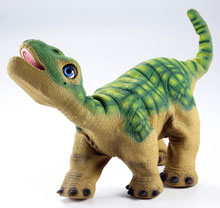After almost a year of delays, the eagerly anticipated robotic toy dinosaur Pleo is now making its way into homes and stores. Pleo is the brainchild of Caleb Chung, cocreator of the Furby, a furry toy robot that enjoyed enormous commercial success in the late 1990s. The Furby came out of the box speaking its own idiosyncratic gibberish but over time learned to use words of human languages that it was exposed to. Pleo, from Chung’s new company, Ugobe, was intended to be the next step in the evolution of robotic toys that exhibit social behaviors and learn from experience.
Other robotic toys on the market have light and sound sensors like Pleo’s, and some can also avoid obstacles, interact with their environments, and indicate emotional states. But with Pleo, Ugobe’s vision was “of life-forms that people could bond with,” says the company’s CTO, John Sosoka. Pleo, he says, “exhibits stunning organic movement and dynamic behaviors unlike other robots in the market.”
Videos showing Pleo’s movement as well as its emotive and biological states do indeed evoke images of beloved pets more than robots. It nuzzles its head against its owner’s cheek in an apparent display of affection. It crouches and wags its tail like a dog that wants to play, or it cranes its neck to let out long, plaintive cries. Pleo’s emotive states include joy, sorrow, and anger. It can also be drowsy or even sick–Pleos sneeze and can transmit colds to each other by way of infrared detection, which also allows them to recognize each other.
Still, Ugobe acknowledges that the toy is not all it was intended to be. A note on the company’s website, addressed to customers who ordered Pleo before its commercial release, says that the software preinstalled in the robot “does not achieve our goal of ‘Pleo learning and developing a unique personality based largely upon how he is raised.’” The note goes on to say, however, that a free software upgrade will be available online in the next year.
Pleo’s hardware consists of 38 sensors, 14 motors, and more than 100 custom-designed gears. Light sensors and a camera in Pleo’s nose help it detect objects, color, and edges. Sound sensors allow some degree of “hearing” when “[Pleo] is still, and it is quiet,” Ugobe says. Eight capacitive touch sensors line Pleo’s shoulders, back, legs, head, and chin.
Some of Pleo’s realism comes from its animal-like movement. The motor in its spine gives it a sort of gator’s gait. “[An alligator] twists and then puts its foot down, similar to Pleo,” Sosoka says. While other robotic toys tend to walk with a series of identical steps, each of Pleo’s steps can vary from the ones before it.
Pleo’s motors have force-feedback sensors that are sensitive to grabbing or pulling: Pleo may limp for a time if its leg is pulled. Tilt sensors detect changes in body position, and four foot switches allow Pleo to recognize that its feet are firmly planted on the ground.
According to Ugobe, the nickel-metal-hydride battery pack in Pleo’s stomach should offer about one hour of play after three hours of recharging, and with consistent use (about one charge per day), the pack should last six to eight months.
The $349 bot was expected in stores last year, and preorders started in June 2007. But Pleo didn’t begin shipping until December 3–just in time for the Christmas shopping season.
According to Sosoka, battery-pack updates were among two notable causes of Pleo’s delay. In an earlier incarnation, the battery charged internally. Now it charges externally.
The other problem that Sosoka cites is Pleo’s skin. “The skin has been one of the most difficult items to perfect on Pleo,” he says. “Pleo’s skin is delicate, and as you pet him, his skin develops a wear pattern.” Sosoka offers a trick to help protect the skin pigment: baby powder, he says, cuts down on friction.
Software problems may also have played a role in the delay. Pleo was intended to have a personality that changed with experience. And although the Ugobe website assures its preorder customers that “Pleo currently interacts with you fully–moving organically, expressing emotion, autonomously exploring and responding to the world around him,” it also acknowledges that the “shaping of personality and temperament” permitted by the bot’s current software is “subtle.”
Nonetheless, response to Pleo has been largely enthusiastic. Tom Hershner, event coordinator of Robot Village, a robotic-products store in New York City, says of Pleo that “there’s nothing else of that caliber of realism,” partly, he says, because of “the look of it.”
“[Other robots] don’t look real: they look robot,” Hershner says. “Pleo looks dinosaur.”

Don’t settle for half the story.
Get paywall-free access to technology news for the here and now.